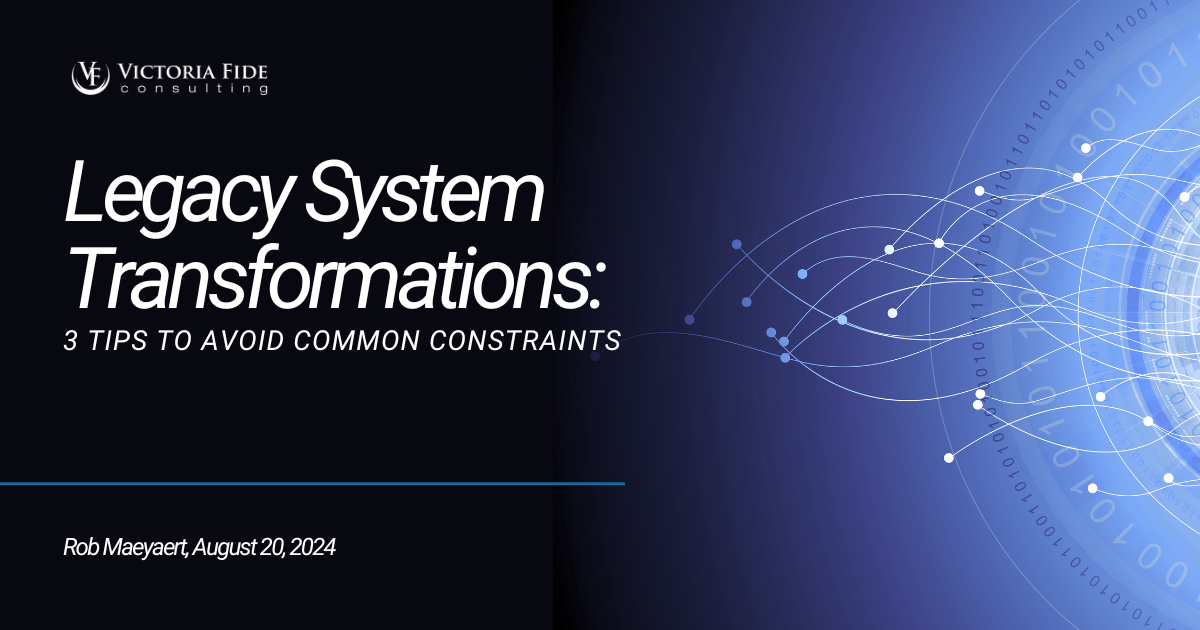
Legacy System Transformations: 3 Tips to Avoid Common Constraints
With the rate of technology innovation increasing exponentially, more and more organizations are suffering from “legacy drag,” a phenomenon in which companies are constrained by outdated systems. As they age, these legacy systems can be more costly to maintain, more exposed to cybersecurity risks, and less effective in meeting their intended purpose. According to this article, 80% of IT budgets go towards maintaining legacy systems. In fact, the Government Accountability Office (GAO) estimated $337M a year goes to simply maintaining the top ten legacy systems used by the US government.
However, the cost of legacy systems goes deeper than the obvious expenses. With the business world in a race to adopt cutting edge technology, businesses who cling to legacy systems face increased competitive disadvantage, missed cost savings, difficulty attracting top talent, and heightened security vulnerabilities.
As your organization investigates undergoing a legacy system transformation – whether adopting new solutions for better platforms, simpler maintenance, or the promise of improved automation and efficiency – consider these three tips to avoid being constrained by outdated systems.
Table of Contents
Tip #1: Consider Your Legacy Data
Organizations often embark on digital transformation projects to introduce new technology solutions, only to be hindered by the complexities of data transformation and migrating legacy data. This aspect is frequently overlooked, rapidly becoming a critical path that causes substantial delays or even prevents project completion.
To ensure the success of your digital transformation efforts, a meticulous plan for data transformation is crucial during the initial stages of the project. Developing a thorough plan that allows adequate time in the schedule for both data transformation and multiple rounds of testing is essential.
You should also decide whether you need to migrate historical data from your legacy system to the new solution. If you choose to do so, consider how much historical data is necessary. Remember, reducing the amount of data to be imported minimizes the time required for data transformation activities and reduces potential issues. Encourage your team to critically assess the necessity of importing extensive data. Some may believe that importing more data is beneficial, but it’s important to clarify its intended use—whether for transactions or simply as historical reference.
It’s vital to recognize that historical data can remain accessible without being imported to the modern platform. Data warehouses or business intelligence solutions provide effective alternatives for storing and reporting on historical data. These approaches can grant access to necessary information while avoiding the extensive and challenging process of data transformation. Ultimately, minimizing the amount of legacy data you transfer will be beneficial in cutting costs, improving system performance, and reducing the potential for errors or setbacks.
Tip #2: Think Beyond “This is how we’ve always done it”
When choosing a modern technology platform that propels your organization into the future and ensures long-term success, it’s essential to move beyond the “this is how we’ve always done it” mindset. Contemporary solutions offer flexibility, which in turn provides options and the potential to enhance organizational processes. This flexibility might involve shifting responsibilities between teams or eliminating certain tasks altogether.
Embrace these changes and seize the chance to improve. Avoid limiting your organization by adapting new solutions to fit exactly like the old system. Similarly, don’t confine your organization to making only minor adjustments to existing processes when there could be far more efficient methods available.
Often, organizations fall into the trap of defining their requirements in a way that replicates legacy system functions rather than exploring new, more efficient approaches. We frequently encounter situations where we demonstrate a revised process, and there is hesitation because some steps from their previous process are no longer needed.
Therefore, approach solution design with an open mind, focusing on outcomes. Identify the expected results of a process and ensure they align with your business objectives. If those criteria can be met more efficiently and effectively, then your solution is moving in the right direction.
Tip #3: Recognize the Significance of Change Management
Managing organizational change is crucial for the success of any digital transformation strategy. Over my 20 years of experience, I have encountered numerous cases where leaders simplify the process of change. This might be because they are disconnected from daily operations, they don’t want to acknowledge any resistance, or because employees do not feel encouraged to express their concerns due to an unsupportive cultural environment.
Diving deeper, there are many legitimate reasons why people might resist change. Change can be deeply personal; many struggle with uncertainty. People often dedicate considerable effort to mastering existing processes and systems, and when these change, they may feel vulnerable, respond defensively, withdraw, or become territorial. I’ve observed these reactions lead to behaviors that cause significant change resistance.
As digital transformation leaders, we must address these challenges and create environments that foster team success and ultimately drive user adoption. Effective modern solutions require a capable team to implement successful transformation. Therefore, developing a robust change management plan is as essential to the success of a legacy system transition as choosing the right modern platform.
Helping Organizations Find Modern Solutions
These are three of the most frequent obstacles organizations encounter before turning to Victoria Fide for assistance in modernizing their operations and selecting innovative solutions. Often, their progress is impeded by their perception of the legacy system and the limitations it imposes. However, it only takes one person with the right perspective and the right position of authority to champion change within their organization.
To learn more about how we can support your organization with solution selection, organizational change management strategies, and additional services, we encourage you to schedule a 30-minute meeting with one of our digital transformation experts. Let us help you navigate the complexities of digital transformation and ensure your business’s success for years to come.

Transformation is not easy, but it doesn’t have to be impossible. Take control of your project’s success today and schedule a free 30-minute consultation to find out how Victoria Fide can equip you for transformational success.
Want to receive these articles in your inbox? Subscribe below:

About the author
Rob Maeyaert is a Director of Project Portfolio and Change Management at Victoria Fide Consulting. For more than 20 years he has worked to help companies implement complex technology solutions and drive their strategic business objectives. For Rob, the most rewarding part of the client journey is building that trusted advisor relationship. Rob works hard to build that through honesty, integrity, and ensuring commitments are followed through.
